| This content applies solely to Connected Onboarding, which must be purchased separately from the Appian base platform. This content was written for Appian 23.1 and may not reflect the interfaces or functionality of other Appian versions. |
The Workflow section of the Connected FS Settings site allows business users to tailor the tasks required for each Onboarding. This page describes how to manage workflow templates.
Business users can add and edit the workflow templates that assign default tasks for a type of Onboarding.
For each Onboarding process, users can set up individual workflow templates to tailor the process to each specific customer.
On the Connected FS Settings site, a grid lists all of the information that is pertinent to Onboarding templates. Users can use this information to determine which templates already exist and when they were last updated.
To view the Onboarding templates, navigate to the Connected FS Settings site and click WORKFLOW.

From here, you have the option to view either Active or Inactive templates. Active templates are ones that are able to be used during runtime processes. Inactive templates are ones that cannot be accessed during a runtime process, but can be edited or activated.
You can search or filter this list for a particular template. Clicking the history icon ![]() will take you to the Template History for that template with a list of all the changes that have been made to it.
will take you to the Template History for that template with a list of all the changes that have been made to it.
After installing the Connected Onboarding application, new Onboarding templates that fit your organization's processes will need to be added.
To create a new Onboarding template:
From the Templates page, click NEW TEMPLATE.
Click CREATE.
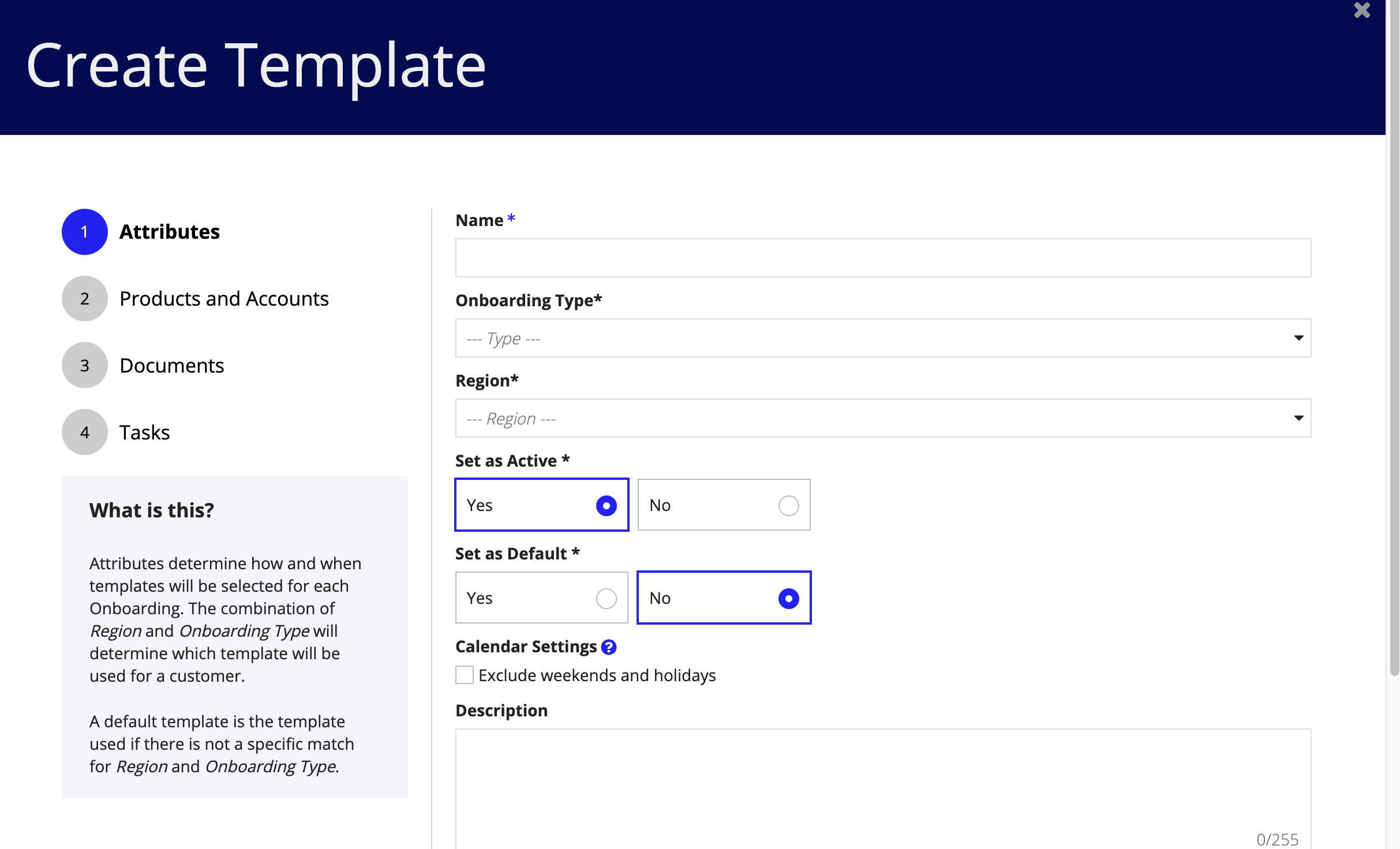
On the document step of the workflow process, document requirements can be added. Each time the template is selected those specific documents will be required to be added during the Onboarding process.
To add document requirements:
On the tasks step of the workflow configuration process, users can add and relate tasks that need to be completed. Some tasks will already be present on this page. If required documents were defined in the documents step, an attach and review document task will be added for each required document.
For onboarding processes, a funding details task will be automatically added to the template and cannot be removed.
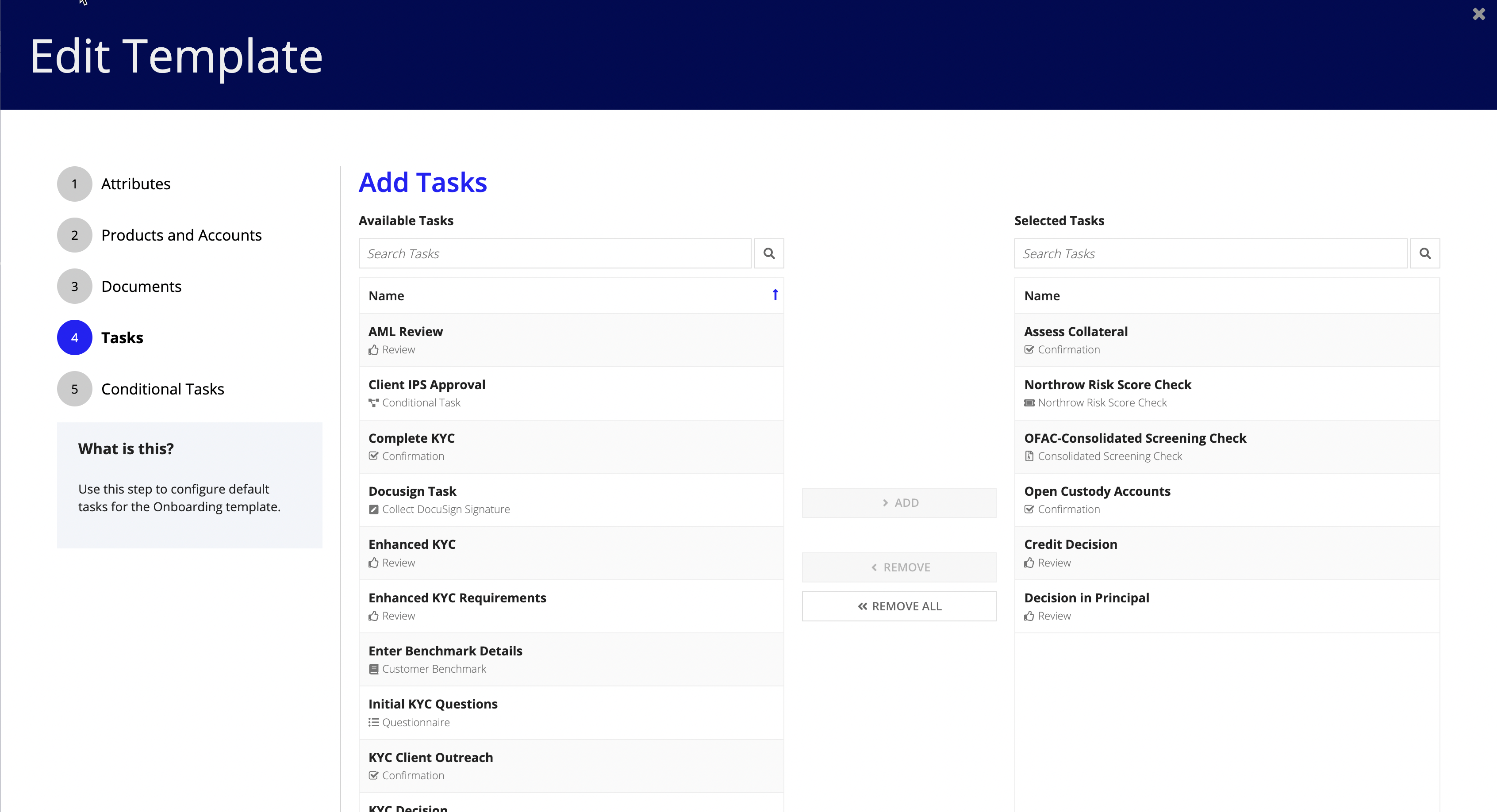
To add additional tasks:
After the tasks are all added, business users can then define the specific task configurations including:
Assigned group: The business unit responsible for completing the task.
Tasks added manually can also be removed from the templates. All tasks are able to be reordered using the up and down arrows before the task name in the grid.
When conditional tasks are added to a workflow, an additional step, Conditional Tasks, will require configuration. Up to this point, you defined response options for each conditional task and its dependents. However, you still need to relate each response option to a dependent such that when a user selects a response option while completing a conditional task the appropriate task dependent is assigned automatically.
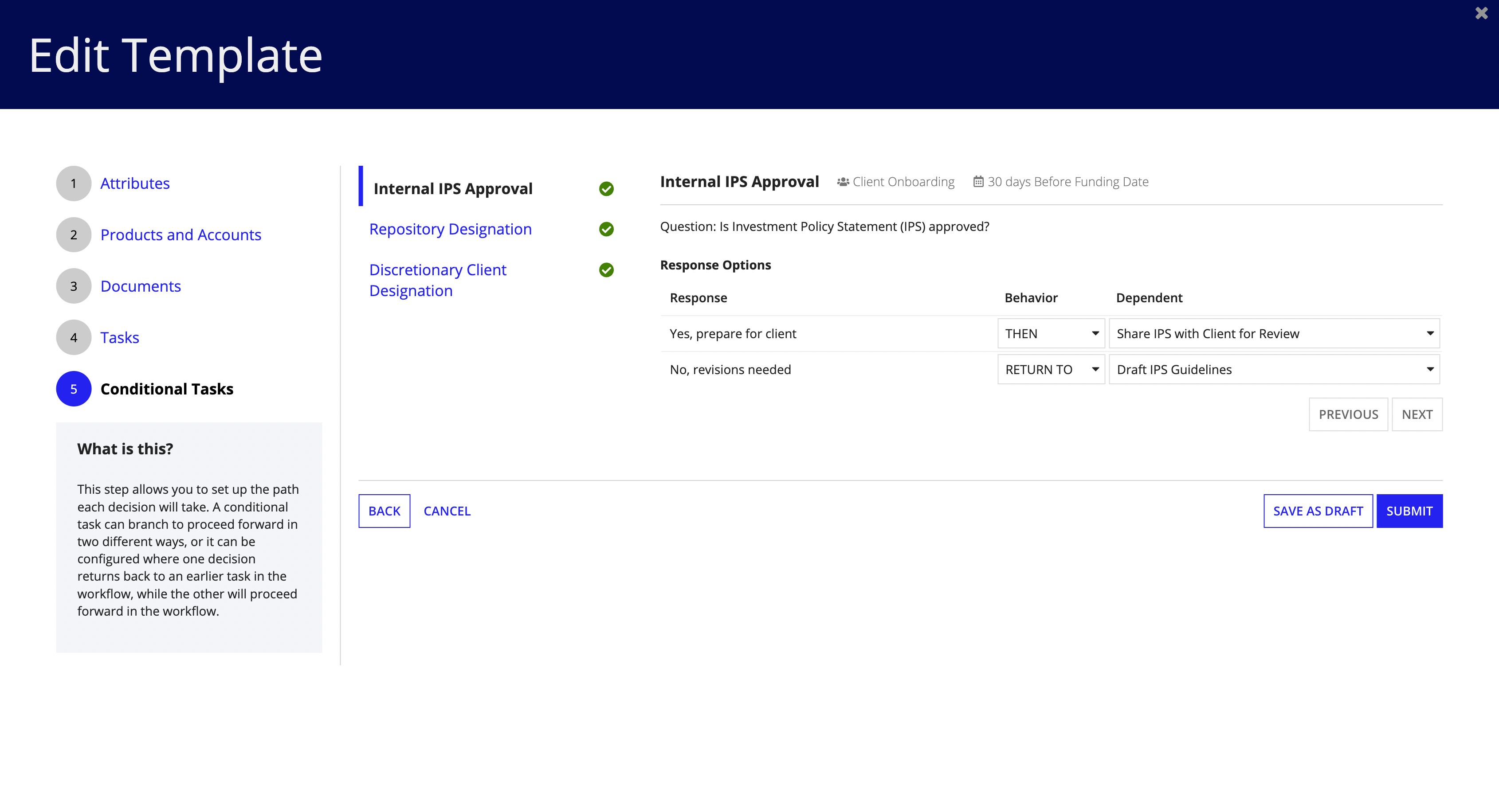
Each conditional task added to the task grid on the Tasks step will be listed in the middle column of the Conditional Tasks page.
To finalize configuration of each conditional task in the workflow, make a behavior and dependent selection for each response option.
Once a conditional task is completely configured, a green check icon will display next to the conditional task name in the middle column.
To proceed to additional conditional tasks requiring final configuration, select the NEXT or PREVIOUS buttons below the response options, or select the conditional task name in the middle column.
When you finish creating the template, click CREATE to save it.
Note: If you need to pause during the process of creating a new workflow template, the solution allows you to quickly save your work as a draft so you do not lose any existing information. See Save as draft for more information.
Business users can manage Onboarding templates from the Connected FS Settings site, this includes updating, cloning, activating or deactivating, and deleting an existing Onboarding template.
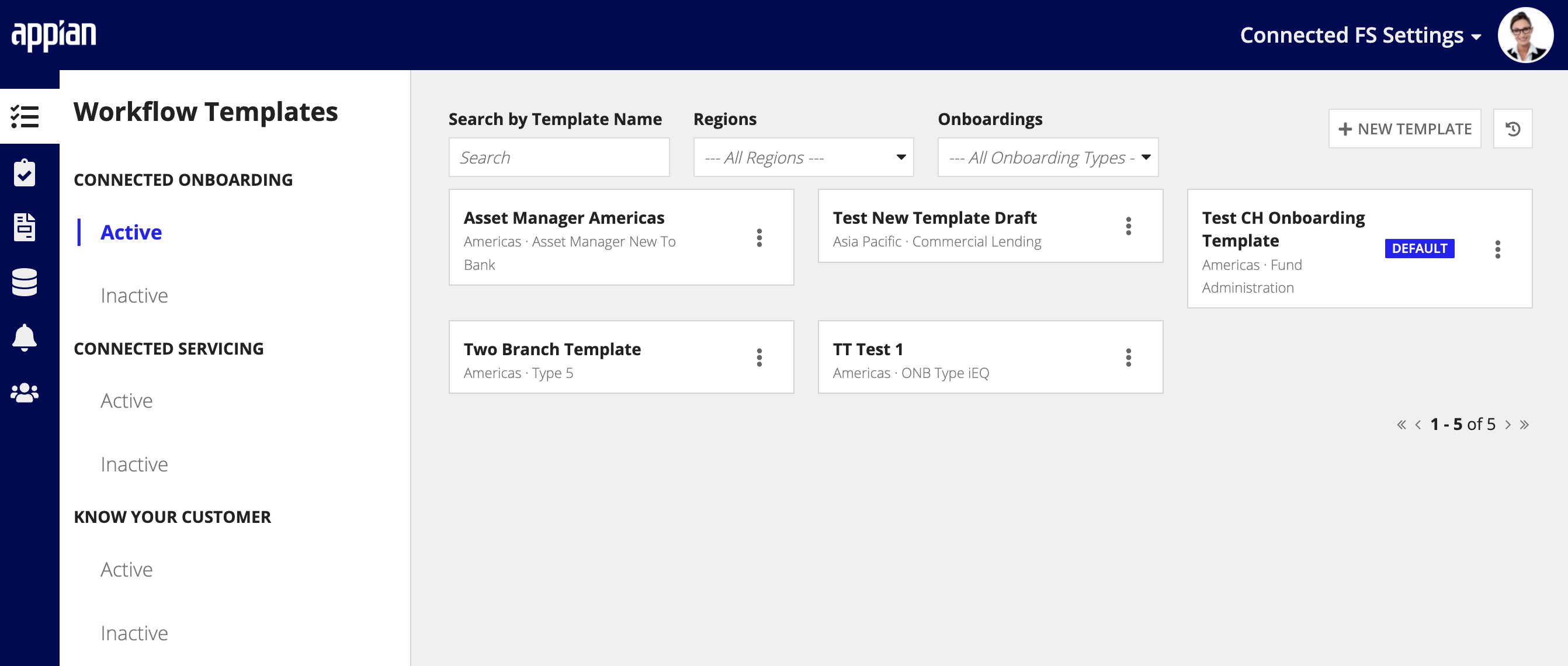
With the Connected FS Settings site, business users can easily and quickly update Onboarding templates with any changes.
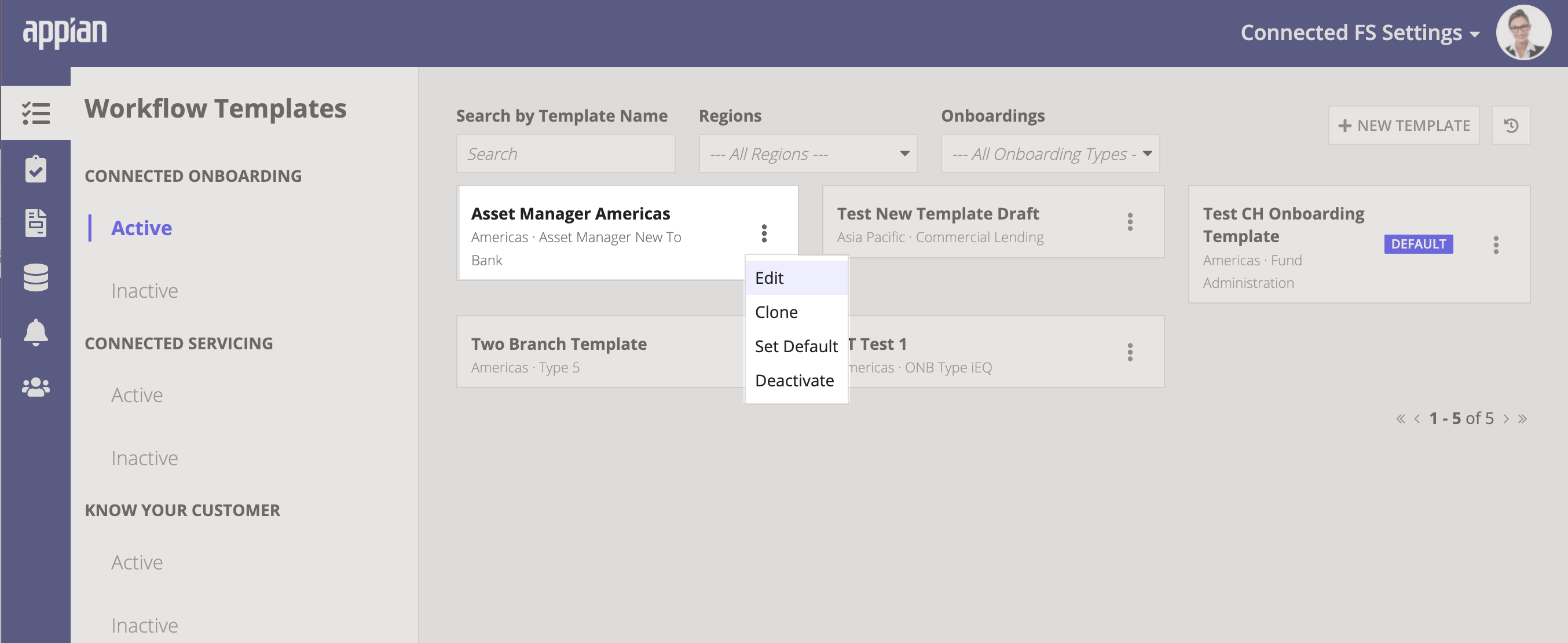
To update a workflow template:
Note: When updating an existing template, you are required to go through each step of the process in order to save your updates.
All future Onboardings will use the modified template. Any Onboardings that are already in process or completed will not be affected.
When a new template is needed and is very similar to an existing template it may be easier to simply clone the existing template and make the minor changes.
To clone a template:
The default template is the template that is used for the Onboarding if there is not a distinct template for the selected onboarding type and customer's region. There can only be one default template, which cannot be deactivated.
You can select the default template by clicking the menu icon and selecting Set Default. The old default template will then be replaced by the current one.
If an active template is no longer needed or is needed in the future but is not ready to go live, business users can deactivate templates. A template can be set as inactive when creating, editing, or cloning an existing template by selecting No under Set as Active.
Note: The Default template cannot be deactivated unless it is saved as a draft or a different template is first set as the Default template.
Templates can be deactivated from the Active template page by selecting the menu icon on a template and selecting Deactivate. Inactive templates are unavailable when creating new Onboarding.
If an inactive template is ready to be used, business users can activate templates so that they are available for use when creating new Onboardings. Templates can be activated when creating, editing, or cloning an existing template by selecting Yes under Set as Active.
Templates can be activated from the Inactive template page by selecting the menu icon on a template and selecting Activate. Active templates can be selected when creating new Onboardings.
If an inactive template is no longer needed, it can be permanently deleted. From the menu icon, select Delete. Confirm that this template is the correct one to be deleted, as the action will not be able to be reversed.
The Appian Connected Onboarding solution is designed with the understanding that an institution’s Onboarding process can be extensive, involving hundreds of steps, and a typical workday is full of interruptions and distractions. As such, SAVE AS DRAFT enables users to create and modify workflow templates to quickly save their progress regardless of validation errors and incomplete required fields.

The SAVE AS DRAFT button is available at the bottom right of each page of the template wizard for creating and modifying templates.

When SAVE AS DRAFT is selected, the user is advised that the template will be saved in the Inactive templates menu with a DRAFT tag applied, and the template will not be available when creating Onboardings while it remains Inactive.

If the default template is saved as a draft, the user will be advised that no template will be identified as the new default template automatically, and defining a new default template is recommended.
A draft template can only be activated after completing all required fields and resolving all configuration errors. See Activate template for specific steps to activate a template.
Configure Workflows